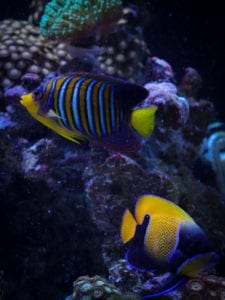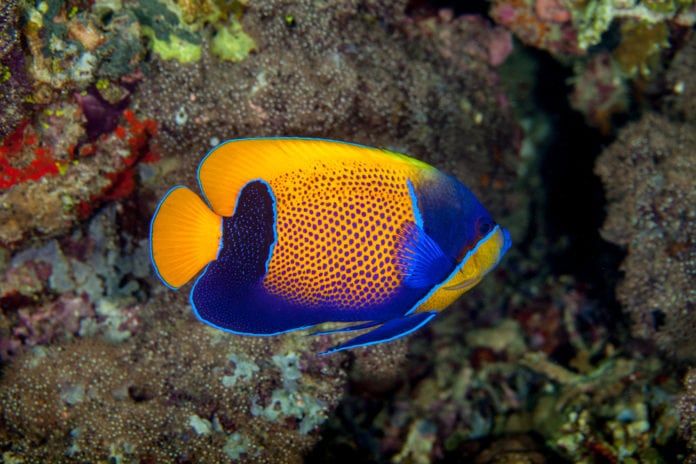Majestic Angelfish or Blue Girdled Angelfish – Pomacanthus Navarchus
- Care: Difficult
- Temperament: Semi-aggressive
- Diet: Omnivore
- Reef Safe: With Caution
- Minimum Tank Size: 125 gallons
The Majestic Angelfish also known as the Blue Girdled Angelfish is from the Pomacanthus family of Angelfish. Known to be more mellow than other Angelfish species, Pomacanthus Angels have impressive awe-inspiring color patterns. Blue Faced Angelfish, Emperor Angelfish and the Majestic Angelfish are all from the same family. The Majestic Angel is a smaller member of “larger” angels. Growing only to around 10 inches it’s also a slow grower, taking many years to reach max size. Like most Angelfish, the Majestic Angelfish is difficult to care for.
Tank Requirements for the Blue Girdled Angelfish
There are several considerations to be taken into account if any saltwater aquarist wants to successfully keep a Blue Girdled Angelfish. Angels, in general, require a large stable and mature system. A 125-gallon tank is suitable, but bigger is better. A system should have a large supply of mature live rock with algae and sponge growth for grazing throughout the day. This species is also shy, especially when introduced to an established aquarium. Caves, hiding places and overhangs are a must with Majestic Angels.
Water Parameters for Blue Girdled Angelfish
Water parameters are equally as important. This species is moderately hardy; however, it’s difficult designation is partly because it requires pristine water conditions. Specific gravity should be maintained between 1.023-1.025, temperature 74-78 degrees Fahrenheit, PH 8.1-8.4, Alk. 8-11.5. A reliable protein skimmer is also a necessary requirement to keep water parameters at optimum levels. The Blue Girdled Angelfish is not tolerant of high nitrates or nitrites. Nitrites should be 0 ppm while nitrates should be maintained at < 5 ppm. These fish also tend to do better in complete reef systems with reef type lighting. Improper lighting can often result in Marine Head & Lateral Line Erosion.
Is the Blue Girdled Angelfish Reef Safe?
Although the Majestic Angelfish is not considered reef safe, I have a Majestic Angelfish in my 175-gallon reef tank. Like many large and dwarf angels, the likelihood of nipping or eating coral depends on the individual fish. Some have been reported to completely destroy softies and LPS coral while others have ignored all coral completely. For example, here is my Majestic Angelfish in a complete reef system. In the background, there are two bounce mushrooms, Deadpool mushroom, Wilsoni, and a Frogspawn colony. Certain species are definitely not reef safe, however, the Majestic Angelfish along with some members of the Pomacanthus genus are less likely to consume coral. SPS corals are considered somewhat safer to house with the Blue Girdled Angelfish.

The Majestic Angel is shy by Angelfish standards. It’s generally peaceful towards most other fish with the exception of other large Angels and conspecifics. It is possible to house two Majestic Angelfish together if they are of the opposite sex, however, there is no reliable way to sex the Blue Girdled Angelfish.
Dietary Needs of the Blue Girdled Angelfish
Their diet should be varied with marine algae, angelfish preparations, mysis shrimp, gut loaded brine shrimp and Spirulina along with the naturally occurring sponge and tunicate colonies within the live rock. They can be difficult to acclimate. If a newly acquired specimen is not eating, feed with live gut loaded brine shrimp to entice the feeding response.
Acceptable tank mates include Tangs, Triggers, Clownfish, Wrasses and other semi-aggressive fish. If possible, add most or preferably all of the larger fish simultaneously to reduce territorial aggression. Failure to do so may result in injury or death. I had to give my Powder Blue Tang to my local LFS because of its aggressive behavior towards my Majestic Angel.
Good semi-aggressive reef safe tank mates from experience include the Yellow Tang, Harlequin Tusk, Flame Angel and Blue Jaw Trigger. Similar to Angelfish, Triggerfish have the reputation of not being reef safe. The Blue Jaw Triggerfish is perhaps the safest Trigger option although all Triggers and most Angels can nip at clams and corals – proceed with caution.
Although difficult to care for, the sheer beauty of the Blue Girdled Angelfish is worth it. This species is considered to be amongst the most desirable in terms of availability, price and aesthetic appeal.
Learn more about caring for Angelfish


















